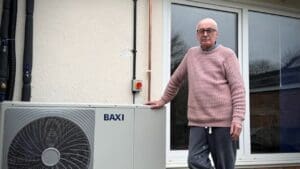As the UK moves towards greener and more sustainable energy solutions, air-to-water air source heat pumps (ASHPs) have become increasingly popular, especially in retrofit projects. These systems offer an efficient, environmentally friendly alternative to traditional heating systems like gas boilers. But how exactly do they work? Let’s explore the science behind air-to-water heat pumps and why they’re an excellent choice for UK homes.
What is an Air-to-Water Air Source Heat Pump?
An air-to-water air source heat pump is a heating system that extracts heat from the outside air and transfers it to your home’s water-based heating system. This can include radiators, underfloor heating, or hot water for taps and showers. Unlike conventional heating systems that burn fuel to generate heat, air source heat pumps simply move heat from one place to another, making them much more energy efficient.
The Basic Principle: Heat Transfer
At the core of an air-to-water heat pump is a process similar to what happens in your fridge but in reverse. The system uses a refrigerant, a fluid that can easily absorb and release heat, to transfer heat from the outside air into your home.
Here’s a step-by-step explanation of how it works:
1. Evaporation:
– The process begins with the evaporator coil, located in the outdoor unit. Even in cold weather, the outside air contains some heat. The refrigerant in the evaporator coil absorbs this heat, causing it to evaporate and turn into a gas.
2. Compression:
– The compressor then compresses the gaseous refrigerant. This step increases the refrigerant’s temperature and pressure, making it much hotter.
3. Condensation:
– The hot, high-pressure refrigerant gas is then passed through the condenser coil, where it releases its heat. This heat is transferred to the water in your home’s heating system, warming your radiators, underfloor heating, or hot water tank. As the refrigerant loses its heat, it condenses back into a liquid.
4. Expansion:
– The liquid refrigerant then passes through an expansion valve, which lowers its pressure and temperature, cooling it down so it can absorb heat from the outside air again. The cycle then repeats.
In this way, the heat pump continuously transfers heat from the outside air into your home’s water-based heating system, providing a steady supply of warmth even in colder weather.
Why Air-to-Water Heat Pumps Are Ideal for UK Retrofits
Air-to-water heat pumps are particularly well-suited for retrofit projects in the UK, where they can replace or complement existing heating systems. Here’s why they’re a great choice:
1. Energy Efficiency:
– Air-to-water heat pumps can be 3 to 4 times more efficient than conventional heating systems because they move heat rather than generate it. This means that for every unit of electricity used, you get three to four units of heat, leading to significant energy savings.
2. Compatibility with Existing Systems:
– These heat pumps can often be integrated with your existing radiators or underfloor heating, making them a flexible option for retrofitting older homes. Some systems may require upgrading radiators to larger or more efficient models, but this is generally a straightforward process.
3. Reduced Carbon Footprint:
Air-to-water heat pumps can significantly reduce your home’s carbon emissions by using less electricity and no direct fossil fuels, especially if the electricity is sourced from renewable energy. This aligns with the UK’s goals for reducing greenhouse gas emissions.
4. Year-Round Comfort:
– In addition to heating, many air-to-water heat pumps can also provide cooling during the summer months, making them a versatile solution for year-round comfort.
5. Government Incentives:
– The UK government offers financial incentives, such as the Boiler Upgrade Scheme, to encourage homeowners to adopt heat pumps. These incentives can help offset the upfront cost, making switching to a heat pump more affordable.
Considerations and Limitations
While air-to-water heat pumps offer many advantages, there are some considerations to keep in mind:
1. Performance in Cold Weather:
– Although air-to-water heat pumps are designed to operate efficiently even in cold UK winters, their efficiency can decrease as the temperature drops. However, modern systems can perform well in temperatures as low as -15°C.
2. Upfront Cost:
– The initial cost of installing an air-to-water heat pump can be higher than traditional heating systems, particularly if modifications to the heating system are needed. However, long-term energy savings and government incentives can help mitigate this.
3. Space Requirements:
– The outdoor unit requires sufficient space and should be placed where it can receive good airflow. The indoor unit and associated pipework may also require space inside your home.
Conclusion
Air-to-water air source heat pumps are a smart, sustainable choice for heating and cooling UK homes, particularly in retrofit projects. By transferring heat from the outside air into your home’s water-based heating system, these pumps offer a highly efficient, eco-friendly alternative to traditional gas boilers. With the added benefits of reduced energy bills, lower carbon emissions, and the potential for government incentives, air-to-water heat pumps are an excellent investment in your home’s comfort and sustainability. If you’re considering upgrading your heating system, an air-to-water heat pump could be the perfect solution for your home.





